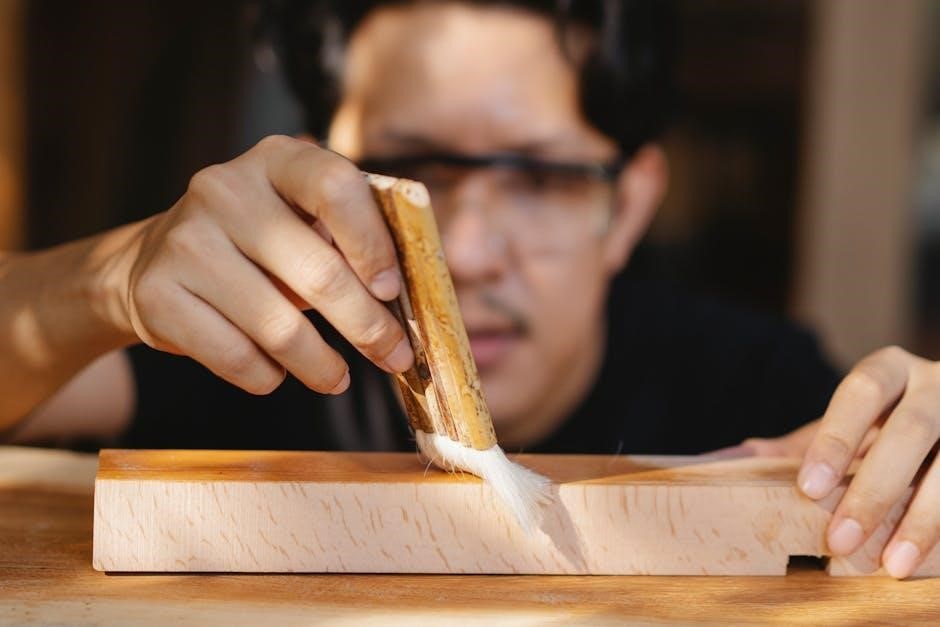craftsman snow blower instruction manual
Welcome to the Craftsman Snow Blower manual․ This guide provides essential safety tips, operational instructions, and maintenance advice to ensure optimal performance and longevity, helping you tackle winter effectively․
Overview of the Snow Blower and Its Features
The Craftsman snow blower is a powerful, two-stage machine designed for efficient snow clearing․ It features a robust auger, high-capacity impeller, and adjustable chute control for precise snow displacement․ The unit is built with durable materials, ensuring longevity and reliability in harsh winter conditions․ Key features include multiple speed settings, a comfortable grip handle, and compatibility with tractor attachments for enhanced versatility․ The snow blower also incorporates safety mechanisms, such as an interlock system, to prevent accidental start-ups․ With its user-friendly design and advanced engineering, it simplifies winter maintenance for homeowners and professionals alike; Adjustability and ease of use make it a top choice for managing heavy snowfall effectively․
Importance of Reading the Manual
Reading the manual is crucial for safe and effective operation of your Craftsman snow blower․ It provides detailed safety guidelines, operational instructions, and maintenance tips to ensure optimal performance․ The manual outlines proper usage techniques, helps you understand the machine’s features, and guides you through troubleshooting common issues․ By following the instructions, you can avoid accidents, extend the lifespan of the equipment, and maintain warranty coverage․ Familiarizing yourself with the content ensures you get the most out of your snow blower while minimizing risks and potential damages․
Table of Contents
This manual is organized into clear sections for easy navigation․ It begins with an introduction, followed by safety precautions and guidelines․ The assembly and installation instructions provide step-by-step guidance․ Operating the snow blower is detailed with pre-operation checklists and control usage․ Regular maintenance routines and troubleshooting tips ensure longevity․ Understanding parts and accessories, warranty information, and environmental considerations are also covered․ Each section is designed to help you maximize efficiency, safety, and performance of your Craftsman snow blower throughout the winter season․

Safety Precautions and Guidelines
Always wear protective gear and follow ANSI standards․ Ensure proper clearance and avoid obstacles․ Keep children and pets away․ Read manual thoroughly before operation․
Understanding ANSI Safety Standards
Craftsman snow blowers meet ANSI safety standards, ensuring compliance with national safety requirements․ These standards cover operational safety, design, and performance․ Always adhere to ANSI guidelines for safe operation, including proper equipment usage and protective gear․ Failure to comply may result in injury or damage․ Refer to the manual for specific ANSI-recommended practices tailored to your snow blower model․
Common Hazards and How to Avoid Them
Common hazards when using a Craftsman snow blower include accidental contact with moving parts, slipping on icy surfaces, and improper handling of hot engines․ Always wear protective gear like gloves and goggles․ Keep loose clothing tied back to avoid entanglement․ Ensure children and pets stay at a safe distance․ Never touch hot surfaces or attempt to clear snow with your hands․ Regularly inspect the machine for damaged parts and ensure proper maintenance to prevent malfunctions․ Adhere to all safety guidelines outlined in the manual for safe and efficient operation․

Assembly and Installation Instructions
- Begin by unboxing and inventorying all parts to ensure nothing is missing or damaged․
- Follow step-by-step instructions for attaching the snow blower to your tractor securely․
- Perform initial setup, including adjusting the chute and auger for proper alignment and operation․
Unboxing and Inventory of Parts
Start by carefully unboxing your Craftsman snow blower to ensure no damage occurred during shipping․ Compare the contents with the parts list in your manual to confirm all items are included․ Check for any visible damage or missing components․ This step is crucial to avoid assembly issues later․ Organize parts by category, such as hardware, attachments, and accessories, to streamline the assembly process․ Once everything is accounted for, proceed to the next step with confidence․
Attaching the Snow Blower to a Tractor
Attaching your Craftsman snow blower to a tractor requires careful alignment and secure fastening․ Begin by positioning the snow blower behind the tractor, ensuring proper alignment with the attachment brackets․ Use the provided pins or bolts to secure the snow blower to the tractor’s hitch or mounting frame․ Tighten all connections firmly to prevent movement during operation․ Refer to your tractor’s manual for specific hitch compatibility and attachment guidelines․ Double-check the PTO (Power Take-Off) connection to ensure it is properly engaged․ Once securely attached, test the setup on a flat surface to confirm stability and functionality before use․
Initial Setup and Adjustments
Begin by unpacking and inventorying all parts․ Attach the snow blower to your tractor using the provided hardware․ Ensure the PTO shaft is securely connected․ Adjust the skid shoes to maintain proper ground clearance, preventing damage to surfaces․ Set the chute direction and angle for optimal snow discharge․ Check the belt tension and ensure all bolts are tightened․ Finally, test the controls and adjust as needed for smooth operation․ Always refer to the manual for specific adjustments and safety guidelines to ensure proper functionality and safety during use․

Operating the Craftsman Snow Blower
Operating the Craftsman Snow Blower involves understanding controls, starting the engine, and adjusting settings for optimal performance in various snow conditions while ensuring safety and efficiency always․
Pre-Operation Checklist
Before starting the Craftsman Snow Blower, ensure all safety precautions are met․ Conduct a visual inspection for damage, wear, or loose parts․ Verify that all controls function properly and the chute is clear․ Wear appropriate safety gear, including gloves and goggles․ Clear the area of debris and obstructions․ Check the oil and fuel levels, and ensure the auger and impeller are free from blockages․ Refer to the manual for specific guidance to ensure safe and efficient operation․ Always follow the recommended startup procedure to avoid potential hazards․
Starting and Stopping the Engine
To start the engine, ensure the snow blower is on level ground and the chute is clear․ Prime the engine as specified, set the choke to the “start” position, and pull the starter cord firmly․ Once running, allow the engine to warm up before adjusting the choke to “run․” To stop, reduce the throttle and turn off the ignition․ Always refer to the manual for specific starting and stopping procedures to ensure safe and efficient operation, adhering to ANSI safety standards․
Using the Controls and Adjustments
Familiarize yourself with the controls, including the chute rotation, deflector angle, and speed settings․ Adjust the chute direction to direct snow where desired, and use the deflector to control the throw distance․ For optimal performance, match the auger and impeller speeds to snow conditions․ Ensure all adjustments are made while the machine is stationary and the engine is off․ Proper use of controls enhances efficiency and safety, aligning with ANSI standards for safe operation․ Regularly check and maintain controls to ensure smooth functionality throughout the winter season․
Navigating Different Snow Conditions
Adjust your approach based on snow type and depth․ For light, fluffy snow, maintain steady progress․ In wet or icy conditions, reduce speed and use the auger’s breaking feature to prevent clogging․ Deep snow requires slower, overlapping passes to avoid overloading the blower․ Avoid pushing too hard, as this can damage the machine․ Use the chute and deflector to direct snow effectively, ensuring even distribution․ Always follow safety guidelines and manufacturer recommendations for handling various snow conditions to maintain efficiency and safety, as outlined in the manual․ Regular maintenance also supports optimal performance in all snow types․
Maintenance Tips During Operation
Regularly inspect and tighten bolts and belts to ensure proper function․ Lubricate moving parts periodically to reduce friction and wear․ Clear debris from the chute and auger frequently to maintain airflow and prevent clogs․ Monitor the scraper blade for wear and replace it when necessary to avoid damaging surfaces․ Check the chute’s rotation and deflector angle to ensure even snow distribution․ Always follow the manufacturer’s maintenance schedule during operation to prolong the life of your snow blower and ensure optimal performance in all conditions․

Regular Maintenance and Care
Regular maintenance ensures your Craftsman snow blower operates efficiently․ Schedule daily, weekly, and seasonal checks, including lubrication, belt inspections, and storage preparation, to extend its lifespan and performance․
Daily Maintenance Checklist
Performing daily maintenance ensures your Craftsman snow blower runs smoothly․ Start by inspecting the auger and impeller for debris․ Check the tire pressure and adjust as needed for proper traction․ Lubricate moving parts like hinges and cables to prevent rust and wear․ Inspect the spark plug for damage or wear and clean or replace it if necessary․ Ensure all bolts and screws are tightened securely․ Finally, review the oil level and top it off if required․ Consistency in these checks will help prevent issues and maintain efficiency throughout the winter season․
Weekly Maintenance Routine
For optimal performance, follow a weekly maintenance routine for your Craftsman snow blower․ Begin by cleaning the exterior and chute of any accumulated snow or debris․ Check the belts for signs of wear or cracks and replace them if necessary․ Inspect the auger and impeller blades for damage and sharpen them if needed․ Drain and refill the fuel tank with fresh gasoline to prevent stale fuel issues․ Additionally, apply a rust-inhibiting spray to metal components to protect against corrosion․ Regular maintenance ensures reliability and extends the lifespan of your snow blower․
Seasonal Maintenance and Storage
After the winter season, perform thorough maintenance before storing your Craftsman snow blower․ Drain the fuel tank completely or add a fuel stabilizer to prevent degradation․ Clean the machine thoroughly, removing dirt and snow residue․ Apply rust-inhibiting oil to metal parts and store in a dry, cool place․ Check for worn or damaged components and replace them․ Proper storage ensures the snow blower remains in good condition for the next season․ Always refer to the manual for specific storage instructions to maintain the warranty and functionality of your equipment․
Checking and Replacing Wearable Parts
Regularly inspect wearable parts like auger belts, scraper bars, and skid shoes for signs of wear or damage․ Replace belts if they show cracks or fraying․ Scraper bars should be replaced when they are worn down to ensure proper snow clearance․ Skid shoes should be adjusted or replaced if they no longer glide smoothly․ Refer to the parts diagram in your manual for identification and replacement guidelines․ Replacing these parts promptly prevents further damage and maintains optimal performance of your Craftsman snow blower throughout the winter season․

Troubleshooting Common Issues
Troubleshooting common issues with your Craftsman snow blower involves identifying problems like clogs, faulty starters, or belt wear․ This section provides troubleshooting tips to help you diagnose and resolve these issues efficiently, ensuring your snow blower operates smoothly throughout the winter season․
Identifying Common Problems
Common issues with your Craftsman snow blower may include clogged augers, faulty starters, or ineffective chute controls․ This section helps you recognize these problems by describing their symptoms and potential causes, such as iced snow, worn belts, or damaged shear pins․ By understanding these indicators, you can address them promptly, minimizing downtime and ensuring your snow blower performs efficiently․ Quick identification of these issues is key to maintaining your equipment and tackling snow removal tasks effectively throughout the winter season․
Diagnosing Engine and Performance Issues
Diagnosing engine and performance issues in your Craftsman snow blower involves checking for common problems like poor fuel quality, clogged air filters, or faulty spark plugs․ Listen for unusual noises or observe reduced power․ Check the fuel level and filter condition․ Inspect the spark plug for wear or fouling․ If the engine stalls or runs rough, ensure the choke is functioning properly․ For performance issues like reduced throwing distance, inspect the auger and impeller for blockages or damage․ Refer to the manual for specific troubleshooting steps to resolve these issues effectively and restore optimal performance․
Repairing or Replacing Faulty Components
When repairing or replacing faulty components on your Craftsman snow blower, always refer to the parts diagram to identify the correct replacement parts․ Common issues include worn belts, damaged augers, or faulty ignition systems․ Start by disconnecting the spark plug for safety․ Use genuine Craftsman parts to ensure compatibility and performance․ Tighten all bolts and screws securely after replacement․ If unsure, consult the manual or contact an authorized service center for professional assistance․ Proper repairs ensure safety and maintain the snow blower’s efficiency and longevity․
When to Contact a Professional
If you encounter complex issues beyond basic troubleshooting, such as major engine problems or electrical system malfunctions, it’s advisable to contact a professional․ Certified technicians at authorized Craftsman service centers have the expertise to diagnose and repair advanced issues․ They use genuine parts and follow manufacturer guidelines to ensure your snow blower operates safely and efficiently․ Additionally, if you’re unsure about handling repairs yourself, seeking professional help can prevent further damage and extend the lifespan of your equipment․

Understanding the Parts and Accessories
This section provides a detailed overview of the snow blower’s components, including augers, impellers, and chute controls, as well as compatible accessories to enhance functionality and performance․
Parts Diagram and Identification
The parts diagram is a visual guide that helps you identify and locate components of your Craftsman snow blower․ It includes detailed illustrations of the auger, impeller, chute, and engine, among other key parts․ Referencing the diagram ensures accurate identification of wearable parts and accessories․ This section is crucial for ordering replacements and understanding how components interact․ The diagram is typically found in the PDF manual or on the manufacturer’s website․ Familiarizing yourself with it aids in routine maintenance and repairs, ensuring your snow blower operates efficiently throughout the winter season․
Key Components of the Snow Blower
The Craftsman snow blower features a robust engine, which powers the machine, and an auger that collects and moves snow․ The impeller propels snow through the chute, while adjustable skid shoes ensure proper ground clearance․ The chute and deflector control snow direction and distance․ Durable tires provide traction, and a user-friendly control panel offers easy operation․ These components work together to deliver efficient snow clearing performance, making it essential to understand and maintain each part for optimal functionality․
Compatible Accessories and Attachments
Enhance your Craftsman snow blower’s performance with compatible accessories․ Options include snow blower belts for optimal power transfer, drift cutters to handle deep snow, and tire chains for improved traction․ Additional attachments like remote chute deflectors and LED light kits can improve control and visibility․ Accessories are designed to fit specific models, ensuring seamless integration and enhanced functionality․ Always refer to your manual for compatibility and installation instructions to maximize your snow blower’s efficiency and versatility during winter tasks․

Warranty and Service Information
Your Craftsman snow blower is backed by a comprehensive warranty․ Register your product for coverage details, and locate authorized service centers for professional assistance and repairs․
Understanding the Warranty Coverage
Your Craftsman snow blower is protected by a comprehensive warranty program․ The warranty covers defects in materials and workmanship for a specified period, ensuring parts and labor are addressed․ Proper registration and adherence to operational guidelines are required to maintain warranty validity․ Refer to the manual for detailed terms and conditions, including coverage duration and exclusions․ Warranty claims must be submitted through authorized service centers, and repairs performed by certified technicians․ Failure to follow instructions may void coverage, so ensure all maintenance and operation guidelines are strictly followed․
How to Register Your Product
To register your Craftsman snow blower, visit the official Craftsman website and navigate to the product registration section․ Provide the required details, including the model number, serial number, and purchase information․ Ensure all data is accurate to validate your warranty․ Registration helps verify ownership and ensures access to exclusive support services․ Follow the step-by-step online process carefully and retain a confirmation for your records․ This process is crucial for warranty activation and future service requests, ensuring seamless support throughout your product’s lifecycle․
Locating Authorized Service Centers
To find an authorized service center for your Craftsman snow blower, visit the official Craftsman website and use the service center locator tool․ Enter your location or ZIP code to find nearby centers․ Ensure the center is authorized to maintain your warranty and provide reliable repairs․ You can also contact Craftsman customer support for assistance in locating a service center․ Always verify the center’s authorization before scheduling any maintenance or repairs to ensure compliance with warranty terms and receive genuine parts and service․
Process for Warranty Claims
For warranty claims, review the manual to ensure your issue is covered․ Contact an authorized service center or visit the Craftsman website to initiate the process․ Provide proof of purchase and a detailed description of the issue․ If approved, repairs will be made using genuine parts․ Follow all instructions from the service center to ensure timely resolution․ Keep records of all communications and repairs for future reference․ Warranty claims must be submitted within the specified period to maintain coverage and avoid additional costs․

Environmental Considerations
Eco-friendly operation tips and proper disposal of old parts are emphasized to minimize environmental impact․ Energy efficiency and responsible usage are key to sustainable snow blower maintenance․
Eco-Friendly Operation Tips
Operate your Craftsman snow blower sustainably by using the correct fuel type and avoiding over-revving the engine․ Regularly maintain the machine to ensure optimal efficiency and reduce emissions․ Always dispose of waste materials like oil and filters responsibly․ Check for energy-saving features and utilize them to minimize power consumption․ Properly store the snow blower during off-season to prevent environmental contamination․ By following these tips, you can reduce your environmental footprint while keeping your snow blower in excellent condition for years to come․
Proper Disposal of Old Parts
When disposing of old Craftsman snow blower parts, ensure environmentally responsible practices․ Check local regulations for hazardous waste disposal, such as batteries or fluids․ Recycle metal and plastic components when possible․ Donate usable parts to repair shops or communities․ For non-recyclable items, use authorized waste facilities․ Proper disposal helps protect the environment and adheres to safety standards․ Always follow local guidelines to ensure eco-friendly practices and prevent contamination․
Energy Efficiency and Savings
Optimize energy use with your Craftsman snow blower by following eco-friendly practices; Use the correct setting for snow depth to avoid over-exerting the engine․ Regular maintenance ensures efficient performance, reducing fuel consumption․ Proper tire pressure and clean filters also contribute to energy savings․ By adhering to these guidelines, you minimize environmental impact and lower operating costs over time․ Energy-efficient operation not only benefits the planet but also extends the lifespan of your snow blower, making it a cost-effective solution for winter maintenance․
By following this manual, you’ll ensure safe, efficient, and effective snow blower operation․ Proper maintenance and adherence to guidelines will extend its lifespan and performance, making it a reliable winter companion․
This manual provides comprehensive guidance for safe and effective operation of your Craftsman Snow Blower․ Key points include adhering to safety standards, proper assembly, regular maintenance, and troubleshooting common issues․ Understanding the machine’s features, following pre-operation checklists, and using eco-friendly practices are emphasized․ Proper storage and warranty information ensure longevity and support․ By following these guidelines, you’ll maximize efficiency, safety, and reliability throughout the winter season․
Best Practices for Long-Term Use
Regular maintenance is crucial for extending the life of your Craftsman Snow Blower․ Always follow the recommended lubrication schedule and inspect wearable parts before each use․ Store the unit in a dry, protected area during the off-season to prevent rust and damage․ Operate the machine according to the manufacturer’s guidelines, avoiding overloading․ Properly dispose of old parts and fluids to minimize environmental impact․ By adhering to these practices, you ensure reliable performance, safety, and efficiency for years to come․
Additional Resources for Further Assistance

For further assistance, refer to the official Craftsman website for downloadable PDF manuals, parts diagrams, and troubleshooting guides․ Visit authorized Sears service centers for professional support․ Explore online forums and communities dedicated to snow blower maintenance․ Utilize customer support hotlines for direct inquiries․ Additionally, consult local hardware stores for specialized tools and accessories․ These resources ensure comprehensive support, helping you maintain and optimize your Craftsman Snow Blower effectively throughout its lifespan․















